Humans have been praising butterflies since ancient times, and they seem to be consistent at home and abroad; poets and poets have written countless popular poems about them; painters often incorporate them into evocative music; even ordinary people can't help but feel excited when they see them. They used vulgar words to express their feelings. Therefore, this insect, known as the "Dancing Queen of Nature", can be said to be closely related to human life.
Butterflies have been favored by literati since ancient times. Butterflies are often mentioned in poems and lyrics. For example, butterflies are deeply loved by the people because of their bright colors. There are many art works with butterflies as the theme in the past dynasties. For example, in the Ming and Qing dynasties, the pattern composed of butterflies and melons represented auspiciousness. The combination of butterflies and flowers made the picture vivid and natural, and the paired butterflies represented the symbol of love. These are adopted by folk customs and have been passed down ever since. There are even more butterfly patterns that can be seen in fabrics, embroidery, stamps and crafts. Artists use the beautiful and colorful butterfly wings to collage them into various art paintings or make large-scale murals, which have high artistic and ornamental value. This kind of murals was once popular in Europe in the 19th century. Some people also use egg whites to paste scales and patterns on walls or cloth to create collage paintings.
1. Zhuang Zhou’s dream of butterfly, praised through the ages - Monarch Silk Butterfly
Parnassius imperator Oberthur
Butterflies first appeared in literary works, probably in the pre-Qin prose masterpiece "Zhuangzi". Zhuang Zhou's Mengdie is one of the famous ones. The article tells that Zhuang Zhou dreamed that he turned into a butterfly, "a vivid butterfly" and "I don't know Zhou Ye". When he woke up, he was surprised to see that he was Zhuang Zhou. Therefore, he was confused, not knowing whether Zhuang Zhou dreamed of becoming a butterfly, or whether the butterfly dreamed of becoming Zhuang Zhou. This fable is to illustrate that the butterfly and Zhuang Zhou, the things and myself, are originally one and there is no difference, so there is no need to investigate. Since then, for more than two thousand years, Zhuang Zhou's dream of butterflies has become an important theme for literati and poets to borrow objects to express their aspirations, and butterfly dreams have become synonymous with dreams. The poem "Jin Se" by Li Shangyin of the Tang Dynasty is full of remembrances of deceased friends and expresses the feelings of joy and sorrow. The poem quotes Zhuang Zhou's allusion of dreaming about butterflies. The first sentence "Zhuang Sheng dreamed of butterflies at dawn" is a metaphor for the unity of things, while the second sentence "Wang Di Wang" "The heart of spring supports the cuckoo" is a metaphor for separation.
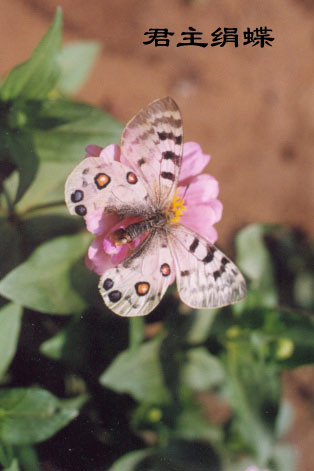
The monarch silk butterfly belongs to the family Lepidoptera, family Serinidae, and is also called the double-beaded silk butterfly or the Kangding silk butterfly. The scientific name means monarch in dreams, and this species is the largest species among the silk butterflies.
Wingspan is 65~80mm. The wings are white with greenish or light yellowish white color, and the female butterfly is dark in color with yellowish-brown veins. There are scattered black scales at the base of the forewing; there is one large black spot at the middle and end of the middle chamber; there is an "S" shaped black horizontal band in the middle of the wing, but the middle part is light in color; the sub-outer edge is serrated and translucent; The outer edge is wide and dark brown translucent. There is one large red spot with white center and black edge at the base, middle and center of the front edge of the hind wing; there are two round black spots with blue center at the sub-outer edge near the hip corner, and there are dots and stripes from the top to the front edge. The outer edge is gray and translucent; the wing base and inner edge are black, and there is another black stripe on the outside. The reverse side of the wings is similar to the front side, but there are 3 to 4 red spots on the base of the hind wings.
Host: Corydalis spp.
Biology: Adults appear in June to July in the distribution area of my country, and are mostly active in high mountain areas above 2000m above sea level.
Distribution: Qinghai, Gansu, Sichuan, Yunnan, Tibet.
2. The legendary story of Zhuang - Ribbon Swallowtail
Sericinus montelus Gray
Alias: Soft-tailed swallowtail butterfly, Aristolochia swallowtail butterfly
There is a poem in Tang Zu's poem "Giving Seedlings to Hair Workers" that says "the silk is long and the pink butterfly flies", which refers to the graceful and graceful ribbon butterfly with a long and slender tail. Due to the obvious difference in wing color between the sexes, the male is simple and elegant, while the female is rich and gorgeous. They are often inseparable, so they are compared to love butterflies that resist feudal marriage. The Ribbon Papilion butterfly belongs to the Papilionidae family.
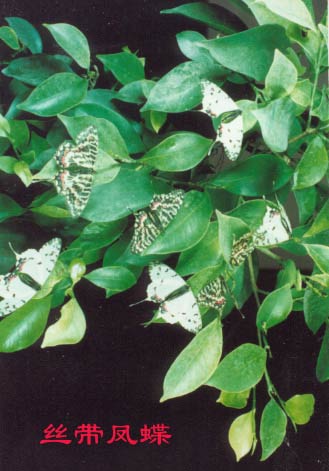
Adult: wingspan 50~60mm. Male and female dimorphism. The wings of the male butterfly are light yellowish white. The base angle, leading edge, top angle and outer edge of the forewing are black or dark brown; there is one black stripe in the middle and end of the middle chamber; there is a row of irregularly sized and irregularly shaped black spots in the middle and rear area (sometimes these black spots are There is red in the spots). There is a middle transverse band on the hind wing, which is connected to a large black spot on the hip corner after being displaced in the middle. There is a red horizontal spot in the large black spot. This red spot sometimes extends intermittently along the middle transverse band to the front edge; there is a blue spot under the red horizontal spot. spots; some have a large black spot in the middle chamber; the length of the tail process is usually shorter than or equal to the female butterfly, and will never be longer than the female butterfly. There are 5 irregular dark brown spots of different sizes and shapes in the middle chamber of the female butterfly's forewing; there are irregular spots on the leading edge, outer edge, sub-outer edge area, mid-posterior area, middle area, base area and sub-unit area. Dark brown spots or bands. There are irregular oblique transverse bands in the base and subunit areas of the hind wings; the middle band is red, dislocated in the rs chamber, reaching the middle rear area directly to the rear edge, and is edged with black; outside the red band (i.e., the sub-peripheral area) It is a black band, with some blue spots between the bands; the outer edge is wavy and black; the tail process is long, black, and the end is yellowish white. The reverse side of the wings is similar to the front side.
Host: Aristolochia contorta Bge.; Aristolochia debilis Sieb.et Zucc.
There are 3 to 4 generations of biology in Beijing every year, and the pupae overwinter under dead leaves, in soil cracks or in topsoil. The overwintering pupae begin to emerge in mid-April of the following year, and late April to early May is the peak emergence period for the overwintering adults. Because the adult stages of the overwintering generations vary and last for up to a month, there is overlap in subsequent generations. Adults mostly emerge during the day, and mating is at its peak in the morning before the dew dries. At this time, adults have low activity and are easy to catch. Overwintering adults lay their eggs on newly unearthed tender stems, often close to the soil surface and difficult to detect. The eggs of subsequent generations are laid on the leaves, tender stems and young fruits of Aristolochia, and some are laid on other plants near Aristolochia or on bamboo poles used as fences. Usually 30 to 50 eggs are laid together. The number of eggs a female butterfly can hold ranges from 100 to 540 eggs. After hatching, the larvae first stay on the egg shell for a while, and then concentrate on the young leaves and stems to cause damage. It first gnaws the epidermis and then bites through it to form holes. The 1st to 3rd instar larvae are gregarious and only disperse and cause damage after the 3rd instar. At this time, the food intake increases sharply. If not treated in time, the leaves, tender stems and peels of Aristolochia can be eaten up, leaving only the bare stems. The larvae are capable of suspended animation. When disturbed, the odor glands immediately secrete odor, and the larvae curl up and roll to the ground. Larvae after the third instar have the habit of migrating in groups to cause damage. After the leaves, tender stems, and young peels of one Aristolochia plant are eaten away, they migrate in groups to nearby Aristolochia plants to feed and cause damage. Older larvae have the habit of climbing higher. Especially mature larvae always crawl to the top of plants or the top of bamboo poles used as fences to spin silk cocoons and pupate on the eve of pupation. Most larvae are 5th instar, and a few are 6th instar.
A kind of Trichogramma sp. was found in the egg stage of natural enemies, and the parasitism rate is higher in the later stage.
Distributed in Beijing, Heilongjiang, Jilin, Liaoning, Hebei, Gansu, Ningxia, Shanxi, Shaanxi, Henan, Shandong, Jiangsu, Hubei, Hunan, Jiangxi, Anhui, Sichuan, Guangxi; the former Soviet Union, South Korea, etc.
3. The incarnation of Butterfly Lovers - Jade Belt Swallowtail
At the end of the Shaoxing opera "Liang Shanbo and Zhu Yingtai", the hero and heroine transform into a pair of butterflies as a symbol of loyal love.
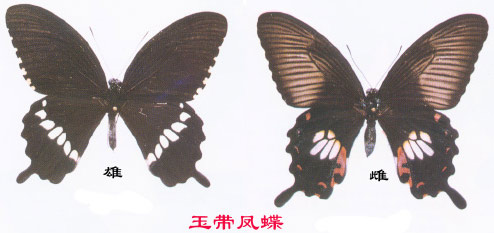
Papilio polytes L.
Also known as the onyx butterfly. Wingspan 77-95mm. The male and female are dimorphic, the markings vary greatly, and the wings are black. There are small white spots on the outer edges of each chamber of the male butterfly's forewings, which are shaped like notches. The white spots gradually become smaller from the rear corner to the front corner; the white spots in the middle of the hind wings are arranged obliquely in a band. There are light red crescent spots on the outer edge of the reverse side.
There are two types of female butterflies, the first type looks like a male butterfly and is very rare; the second type is a common type, with no white spots on the outer edges of the forewings, and red crescent moon spots on both the front and back of the hind wings; there are 4 long spots in the middle, and the stripes are In color, most individuals are two white and two red, and very few are completely white. Some individuals still have a small stripe at the end of the middle chamber. Larvae damage tangerines.
Distribution: Distributed south of the Yellow River in my country; distributed abroad in India, Malay Peninsula, Japan and other places.
4. Enter the world of stamps
Although stamps are only a square inch in size, they are the crystallization of national culture, science, and technology, and reflect the rise and fall of a country's politics and economy. Stamps are the country's business card and the window to science. In the animal world, the butterfly is the one that people love the most and has the most stamps issued. The book "World Butterfly Stamps" compiled by Shou Jianxin and Zhou Yao (1990) collected 563 butterfly stamps of 323 species in the world, including a set of 20 stamps of 20 species in mainland my country. Now I will introduce the butterfly stamps of mainland my country and the butterflies they represent.
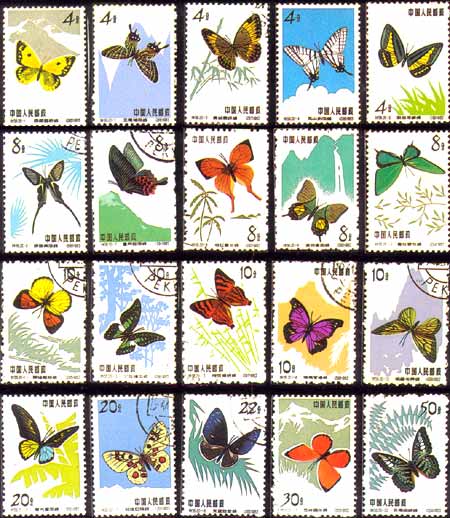
Graphium eurypylus (Linnaeus)
Alias: The flower-shaped blue swallowtail butterfly, the Y-shaped blue swallow-tail butterfly, the Y-shaped blue swallow-tail butterfly, and the Y-shaped blue swallow-tail butterfly.
The adult wingspan is 65 to 72 mm. The back of the body is black and the belly is grayish white. The wings are black or light black, with light green markings; there are 5 markings of different thicknesses on the middle chamber of the forewings; there is a row of small spots on the sub-outer edge, and a single small spot on the sub-apical corner; there is a row of spots on the middle area, Except for the third spot, this series of spots increases roughly from the front edge to the rear edge; there is another fine spot below the middle chamber, which is divided by veins. The spots on the front edge of the hind wings are grayish white, with a small triangular white spot separated at the base; there are 2 long spots immediately below it, heading towards the hip angle; there is a row of small spots in the sub-outer edge area; the outer edge is wavy, with white edges at the troughs. The underside of the wings is dark brown, and some of the markings are silvery white. The spots on the middle chamber and sub-outer edge of the forewings have silvery white edges. There are 3 to 4 red spots on the lower half of the middle and rear area of the hind wings; some have 1 red spot on the inner edge.
Host: Annona reticulata, Annona muricata, Mitrephora froggattii, Polyalthia nitidissima and other plants of the Annonaceae family.
Biology: Adults mostly occur between May and October. They are common in low-altitude hilly woodlands and mountainous forest edges, and fly on the roadside.
Distribution: Yunnan, Sichuan, Hainan, Guangdong, Guangxi; Sikkim, Sri Lanka, India, Myanmar, Thailand, Malaysia, Vietnam, Australia.
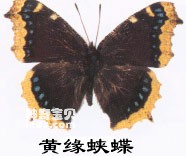
5. See the butterfly through flowers - Yellow-margined butterfly
Du Fu wrote in his poem "Two Poems on the River Qujiang": "You can see the butterfly deeply through the flowers, and the dragonflies are flying in the water." The butterfly flies among the flowers to feed, mate, and lay eggs, and the dragonfly touches the water to lay eggs. , which looks like it will fly at the touch of a touch, and is painted lifelike.
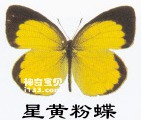
6. Double-flying West Garden Grass - Star Yellow Pink Butterfly
In the poem "Long Trunk Shape", there is a sentence: "Butterflies are yellow in August, flying on the grass in the West Garden." Yang Wanli of the Southern Song Dynasty's "Two Poems from Xugongdian, Suxin City" says: "Children rush to chase yellow butterflies, flying Enter cauliflower and nowhere to find it." It is about the scene where the yellow pink butterfly likes to fly among the yellow rapeseed flowers. Due to the protective color of this butterfly, the butterfly and the flowers are the same color, making it difficult to distinguish them.
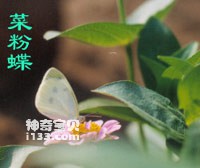
7. Where to find the cabbage butterfly that dances into pear blossoms
Xie Yi of the Northern Song Dynasty described in "Butterfly": "Sometimes you can see it wildly following the catkins, but you can't find it dancing into the pear blossoms." It means that the cabbage white butterfly flies in the white pear blossoms. Because the colors of the flowers and butterflies are the same, it is difficult to find them. The scene of searching.
Also known as white butterfly. The wingspan is 40-52mm, the wings are white, the top corner of the forewing and the middle part of the two spots are black, and there is a black spot on the front edge of the hind wing; the base of the wing and the front edge of the forewing are dark, and the female butterfly is obviously darker than the male butterfly. On the reverse side, the base of the front wings, the top corner and the hind wings are light yellow. Damages cabbage and other cruciferous vegetables when young.
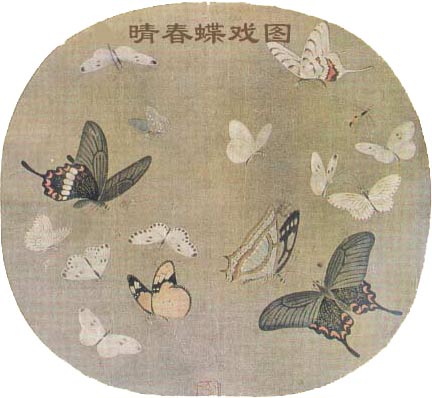
8. Butterflies Playing in Sunny Spring
The Palace Museum in Beijing houses many famous paintings from the past dynasties of the motherland. Among them is a Song Dynasty painting called "Butterfly Opera in Sunny Spring". The picture is clear and vivid, with more than ten colorful butterflies, brightly colored and graceful. This painting is said to have been created by Li Anzhong, a painter of the Southern Song Dynasty. The size proportions, morphological characteristics, and color patterns of various butterflies in the painting are mostly similar to the real objects and lifelike. Although thousands of years have passed, it is still possible to identify the butterfly species that were produced near the capital of Lin'an (now Hangzhou) in the Southern Song Dynasty. In some species, the male and female can be clearly and unmistakably identified.
animal tags:
We created this article in conjunction with AI technology, then made sure it was fact-checked and edited by a Animals Top editor.